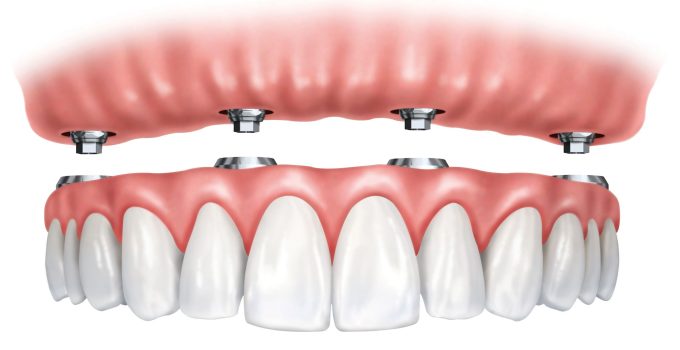If you have lost several teeth, you might have considered various options for replacement. Among these options, one stands out due to its permanence, comfort, and functionality: full arch dental implants. This in-depth article will provide a comprehensive overview of this dental procedure, discussing how it works, its benefits, potential drawbacks, and how it compares to other solutions.
Understanding Full Arch Dental Implants
Full arch dental implants, as the name suggests, are a dental treatment procedure designed to replace all of your teeth in a single arch (either upper or lower). Typically, this procedure involves the placement of four to six titanium implants into your jawbone. These implants act as anchors for a full arch of prosthetic teeth, which are designed to look, feel, and function like your natural teeth.
This procedure is often recommended for individuals who have lost a significant number of teeth due to injury, decay, or disease. It can also be a suitable choice for those who currently wear dentures but are dissatisfied with their comfort or functionality.
Benefits of Full Arch Dental Implants
Full arch dental implants offer several distinct advantages over other methods of teeth replacement. For one, they provide a permanent solution for missing teeth. Unlike dentures, which are removable and may require periodic adjustments or replacements, dental implants are designed to last a lifetime with proper care.
Another significant benefit is the improved functionality. With full arch dental implants, you can eat, speak, and smile with confidence, knowing that your new teeth are secure and stable. They won’t slip or move around as dentures might. This leads to enhanced self-esteem and quality of life.
Furthermore, full arch dental implants preserve the health of your jawbone. When teeth are lost, the jawbone can begin to deteriorate due to lack of stimulation. Dental implants mimic the function of natural tooth roots, stimulating the jawbone and preventing this bone loss.
Lastly, dental implants are easy to maintain. They can be cleaned just like your natural teeth through regular brushing and flossing, and they don’t require any special cleaning solutions or adhesives.
Procedure for Full Arch Dental Implants
The procedure for full arch dental implants is relatively straightforward, but it does require multiple visits to the dentist. First, any remaining teeth in the arch are removed, and the jawbone is prepared for implant placement. This can involve bone grafting if the jawbone is not dense enough to support the implants.
Next, the titanium implants are placed into the jawbone. These implants will need several months to fuse with the bone, a process known as osseointegration. Once the implants have fully integrated, the full arch of prosthetic teeth is attached to the implants.
This procedure is typically performed under local anesthesia, but sedation options are also available for patients who are anxious or nervous about dental procedures. For more information about the procedure, the Full arch dental implants website can provide further details.
Potential Drawbacks of Full Arch Dental Implants
While full arch dental implants offer many benefits, they may not be the best solution for everyone. One potential drawback is the cost. Dental implants are one of the most expensive options for tooth replacement, and they are not always covered by dental insurance.
Additionally, the procedure for full arch dental implants is more invasive and time-consuming than other options. It requires surgery to place the implants into the jawbone, and there is a healing period of several months before the final prosthetic teeth can be attached.
Finally, not everyone is a good candidate for dental implants. Factors such as inadequate bone density, certain systemic diseases, and smoking can affect a person’s eligibility for this procedure.
Comparing Full Arch Dental Implants to Other Solutions
When compared to other solutions for missing teeth, full arch dental implants are often the superior option. Dentures, for example, do not offer the same stability or functionality. They can slip or move around in the mouth, making eating and speaking difficult. Furthermore, they do not prevent bone loss in the jaw, and they require special care and cleaning.
Partial dentures or bridges, meanwhile, only replace a few missing teeth at a time. For individuals with many missing teeth, this would require multiple procedures and could result in a less natural-looking result.
Full arch dental implants, on the other hand, offer a complete, permanent solution for missing teeth. They look and function like natural teeth, and they help maintain the health of your jawbone. For more comparison details and to find a provider, consider the dental implants California page.
Conclusion
Full arch dental implants provide a robust, permanent solution for those missing many or all of their teeth. While the procedure is more costly and invasive than other options, the benefits—including improved functionality, bone preservation, and ease of maintenance—often outweigh the drawbacks for many individuals. As always, it’s essential to discuss your options with a dental professional to make the best decision for your oral health and lifestyle.
FAQs
Q: How long do full arch dental implants last?
A: With proper care, full arch dental implants can last a lifetime. This includes regular brushing, flossing, and dental check-ups.
Q: Are full arch dental implants painful?
A: The procedure is performed under anesthesia, so patients should not feel pain during the surgery. There may be some discomfort or swelling after the procedure, but this can usually be managed with over-the-counter pain relievers.
Q: Can anyone get full arch dental implants?
A: While many people are candidates for full arch dental implants, not everyone is. Factors such as bone density, overall health, and smoking habits can affect eligibility for this procedure.



